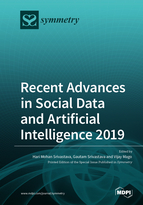Recent Advances in Social Data and Artificial Intelligence 2019
A special issue of Symmetry (ISSN 2073-8994). This special issue belongs to the section "Computer".
Deadline for manuscript submissions: closed (30 April 2021) | Viewed by 117172
Special Issue Editors
Interests: real and complex analysis; fractional calculus and its applications; integral equations and transforms; higher transcendental functions and their applications; q-series and q-polynomials; analytic number theory; analytic and geometric Inequalities; probability and statistics; inventory modeling and optimization
Special Issues, Collections and Topics in MDPI journals
Interests: blockchain technology; cryptography; big data; data mining; social networks; security and privacy; anonymity; graphs
Special Issues, Collections and Topics in MDPI journals
Special Issue Information
Dear Colleagues,
The importance and usefulness of subjects and topics involving social data and artificial intelligence are becoming widely recognized.
In this Special Issue, we cordially invite and welcome review, expository, and original research articles dealing with the recent advances in the subjects of social data and artificial intelligence, and potentially their links to Cyberspace.
Cyberspace, the seamless integration of physical, social, and mental spaces, is an integral part of our society, ranging from learning and entertainment to business and cultural activities, and so on. However, there are a number of pressing challenges associated with cyberspace. For example, how do we strike a balance between the need for strong cybersecurity and preserving the privacy of ordinary citizens?
This Special Issue has emerged from the International Conference on Social Data and Artificial Intelligence (SDAI 2020) held in Toronto, Canada on 26–27 May 2020 and the IEEE Cyber Science and Technology Congress (CyberSciTech 2020) which will also be held in Canada (CyberSciTech 2020, Calgary, Canada, 22–26 June 2020).
To address the challenges described for both conferences, there is a need to establish new science and research portfolios that incorporate social data and artificial intelligence alone or in combination with cyber-physical, cyber-social, cyber-intelligent, and cyber-life technologies in a cohesive and efficient manner.
Prof. H. M. Srivastava
Prof. Gautam Srivastava
Prof. Vijay Mago
Guest Editors
Manuscript Submission Information
Manuscripts should be submitted online at www.mdpi.com by registering and logging in to this website. Once you are registered, click here to go to the submission form. Manuscripts can be submitted until the deadline. All submissions that pass pre-check are peer-reviewed. Accepted papers will be published continuously in the journal (as soon as accepted) and will be listed together on the special issue website. Research articles, review articles as well as short communications are invited. For planned papers, a title and short abstract (about 100 words) can be sent to the Editorial Office for announcement on this website.
Submitted manuscripts should not have been published previously, nor be under consideration for publication elsewhere (except conference proceedings papers). All manuscripts are thoroughly refereed through a single-blind peer-review process. A guide for authors and other relevant information for submission of manuscripts is available on the Instructions for Authors page. Symmetry is an international peer-reviewed open access monthly journal published by MDPI.
Please visit the Instructions for Authors page before submitting a manuscript. The Article Processing Charge (APC) for publication in this open access journal is 2400 CHF (Swiss Francs). Submitted papers should be well formatted and use good English. Authors may use MDPI's English editing service prior to publication or during author revisions.
Keywords
- Social data inadequacies and inconsistencies
- Predictive models of social behaviors
- Infrastructure and architecture for testing social theories
- Data collection and analysis platforms
- Relevance of IoT for social science theories
- Building capacity to continuously collect data across a range of social media networks
- Designing efficient parsers to deal with noisy social media data-sets for real-time tracking of health issues, diseases, and wellness
- Designing tools to map and measure the effectiveness of health campaigns by healthcare organizations
- Cross-validating the predictive models of social media data-sets with ground truth data
- Developing frameworks and algorithms to perform real-time analysis of social media data-sets
- Cyberspace theory and technology
- Cyber social computing and networks
- Cyber life and wellbeing
- Cyber intelligence and cognitive science








